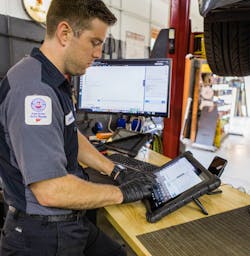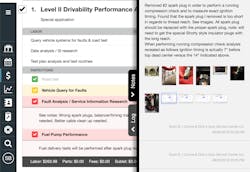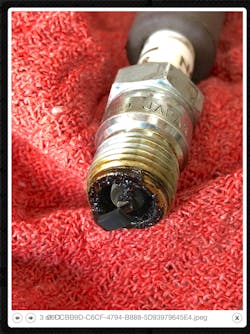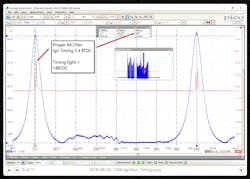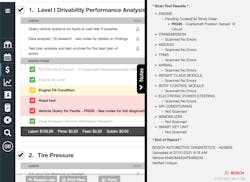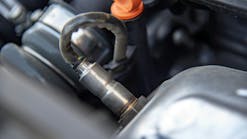Documenting your diagnostic and repair processes
I don’t think anyone ever wants to end up in court, but this is where I found myself a few decades ago when I had to explain to a judge about a repair that went sideways in our shop. The key takeaway for me was simple and that was the judge was looking for documentation that told the story of what transpired during the vehicle’s repair visit. I soon realized how important it is to document the entire flow of the vehicle as it enters the shop and as it exits the shop and everything that happened in between. From that moment forward it has been our policy to ensure that the repair order contains documentation that establishes the facts so that it can stand on its own and tell an accurate story about what transpired during each vehicle visit.
“Just to check it?”
We hear this statement all too frequently and I believe that it’s primarily driven by the fact that the consumer simply doesn’t understand how complex their automobile is nor the appreciation for the skills and expertise needed to properly address vehicle anomalies. This is where documentation can help to establish value by properly articulating what was done to the vehicle so that the consumer has a better idea of what they’re paying for. Diagnostic services consume a lot of our available production time but is necessary to achieve a proper pathway leading to an effective repair. Without this crucial step, one is unable to accurately prescribe the proper repairs and services to reach a positive outcome. I strongly believe that if the customer can clearly see the effort that went into analyzing their vehicle anomalies along with the verification steps that ultimately lead to a diagnosis, they would feel much better about paying for that service.
Additionally, if you can include additional visual assets such as screenshots from your diagnostic equipment (Figure 2), photos of good vs. bad parts, videos, and other digital assets, this will no doubt reinforce your diagnostic and inspection services and will secure consumer trust. At the same time, it will elevate your brand credibility.
Case study
A customer that was referred to us brought in his very clean '67 Chevelle with a complaint of poor driveability, poor idle, etc. He explained to us that he had just had the engine rebuilt and it has never run right since. We examined the vehicle’s engine performance and began performing analysis and all along the way we documented our findings (Figure 3).
After we acquired a running compression test, we began to analyze the data. One of the first observations we made was that the actual spark event was taking place at 5.4 degrees BTDC and not at the 14-degrees BTDC indicated by the timing light and marks (Figure 6). The valve timing events were measured and noted. Additionally, the idle compression peaks were observed at 110 psi, which is high but assumed acceptable based upon the engine performance modifications.
Based upon our findings, we recommended installing the correct spark plugs, set the ignition timing using the in-cylinder pressure method, and fine tune the air-fuel ratio across the engine operating range.
The customer contacted us a few months later to tell us that the vehicle has been running fine and that the fuel mileage went from 10 mpg to 14 mpg but was concerned that the engine had low compression based upon our data. We proceeded to explain to the customer that a running compression test is usually 60 to 65 percent of what one would observe during a cranking compression test (Figure 6).
Performing documentation like this indeed can take additional time but, in the end, it’s well worth it. The documentation is the story that illustrates exactly what happened as a vehicle entered the service center, what was done, what wasn’t done, and what was recommended. Some shop management systems make it very easy to integrate their inspection items and subsequently include additional rich assets alongside descriptive text. Some applications can be accessed by using a smartphone or tablet which allows a technician to use the voice-to-text feature instead of typing out a long story. Initially this may take a little bit of practice but once you get this down, it becomes easy to handle. Many scan tools and diagnostic equipment on the market today are web connected which can be a good thing, especially if the device has a web browser and your shop is using a shop management system that can be accessed through the web (Figure 8).Modern tools
During every maintenance service at my shop, we perform a vehicle health-check scan of all modules for diagnostic trouble codes (DTCs). We take that report and digitally attach it to the repair order. Most of our scan tools today are PC/tablet based and have web access which allows us to move the report right into the notes section of the repair order quickly. In most cases the scan tool will output the report as a PDF that is then attached to the invoice digitally. Recently, I discovered that the Bosch 525X and 625X can automatically place the results of a vehicle DTC scan right into the notes section of the repair order (Figure 7). To me, this is a huge deal because it eliminates the steps outlined above. The beauty here is that the scan can be initiated while the technician is performing other tasks because the scan doesn’t require any monitoring or post-scan operations. Additionally, when the technician completes repairs and clears the DTC’s with the scan tool, the new DTC report will be uploaded to the repair order automatically.
Many of the handheld diagnostic tools such as Autel, Launch Tech, MAHLE, and others will output a clean PDF report that can be attached to the work order. In some cases, the PDF report can be customized with your company name and logo which can go a long ways towards elevating your brand.
Proper documentation can help in more ways than one. With new technologies coming our way, look for methods that will help you document easier through the transfer of data from your diagnostic tools right into your repair orders automatically. Additionally, using your smartphone or tablet to capture video and audio can go a long way towards helping your clients understand more about their vehicles and what it takes to keep them operating properly.
